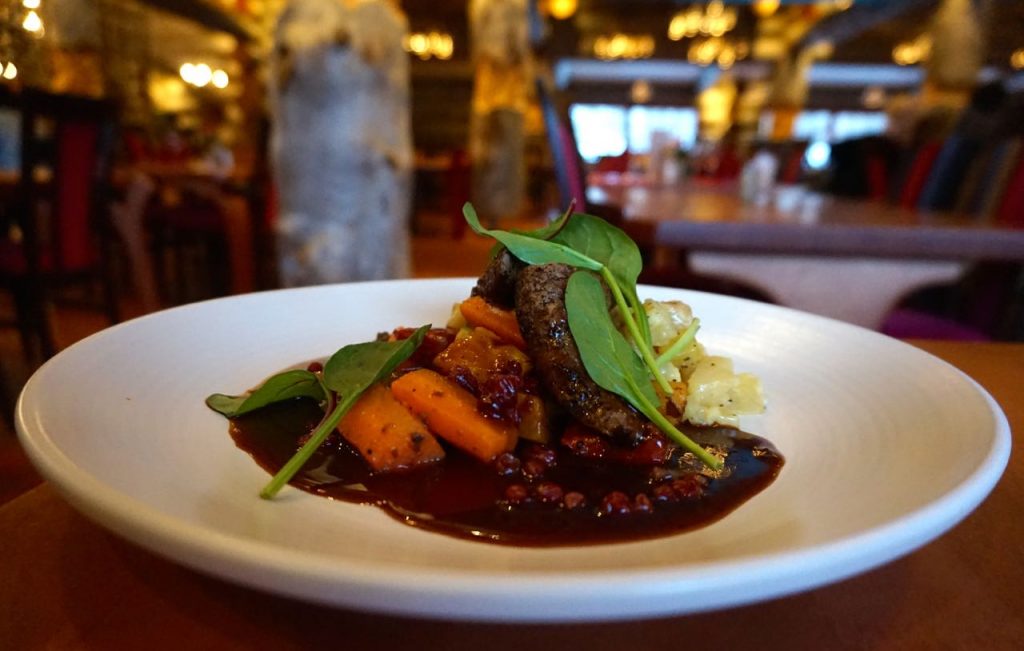I had seen countless pictures of Kakslauttanen Arctic Resort, the iconic igloo hotel, but being there was surreal. Even in April, the town of Ivalo was white as far as the eye could see. In forests covered in snow, reindeer peeked out from behind the trees, and the faint sound of barking Husky dogs could be heard in the background. I had arrived in Lapland, roughly 150 miles north of the Arctic circle!

Credit: Sucheta Rawal/ goeatgive.com
The resort itself is built to represent a winter wonderland. There are cabins and glass igloo rooms from where you can see the northern lights dancing above your head. During the day, one can go hiking, dog sledding, cross-country skiing, and drive snow mobiles. Santa Claus lives on premises year-round and visitors can stop by his home and take part at his grandiose holiday celebrations.
As I explored this snow-covered lifestyle, a looming question remained in the back of my mind: What would Santa eat?
Did you know? The myth that Santa comes from Finnish Lapland, began with an illustration in Harper’s Magazine in 1866.
Lappish cuisine is based on what the natives, called Sami people, found in the area – a lot of meat, fish and berries. Here are some of the dishes I ate during my stay at the igloo.
Reindeer
Reindeer meat can be found all over Finland. From the time I landed in Helsinki, all I saw were reindeer sausages, kebabs, hamburgers, stews and jerky. In Finland, reindeer are free to roam through the forests and are not commercially farm raised. When a reindeer is slaughtered, it is done so in a sustainable manner, so each part of its body (including bones and blood) is put to good use.
So, how does it taste? Reindeer meat is actually quite soft and lean compared to other dark meats. It tastes like the softest cut of beef and is quite filling.

Credit: Sucheta Rawal/ goeatgive.com
Did you know? Reindeer meat contains only 4% fat and is rich in omega-3, omega-6, B-12, zinc and iron.
Berries
Berry picking is a popular activity in Lapland and many families take trips to the forests to stockpile cloudberries, crowberries, lingonberries, blueberries and cranberries. They make jams, jellies, liquors and juices. Of course, berries showed up in practically every cocktail, sauce and dessert I had in Lapland! The Lappish squeaky cheese baked with tart cloudberries was my favorite dessert.

Credit: Sucheta Rawal/ goeatgive.com
Did you know? Many believe that cloudberries are a source of youth, as they contain a lot of anti-oxidants that protect against cancer and heart disease, and reduce the process of aging.
Root Vegetables
Turnips and potatoes are the most common veggies you will find as accompaniments to any dish. They may come mashed or roasted, simply seasoned with salt and sometimes dill. Don’t expect a vegetarian diet except the occasional cabbage, carrot or mushroom (when in season).
Bread
Finnish breakfast always starts with whole meal breads made of rye, barley or oats, with butter and ham. I couldn’t stop eating the Karelian pasty, a traditional Finnish dish made from a thin rye crust with a rice filling.
Seafood
Finland is known as the land of one-thousand lakes. Most of the seafood comes fresh from the lakes, Baltic and Arctic. I had some of the most delicious salmon, whitefish, cod, and crab during my stay in Lapland. Boiled shrimp, crayfish and pickled herring are also quite popular in Finland.

Credit: Sucheta Rawal/ goeatgive.com
Did you know? In the old nomadic society, cooking was carried out by the man. He was the one who handled the meat and cooked the stew.
Did that make you hungry? If you found yourself sleeping in an igloo at the North Pole, what foods would you crave the most? We’d love to hear in the comments section below.

